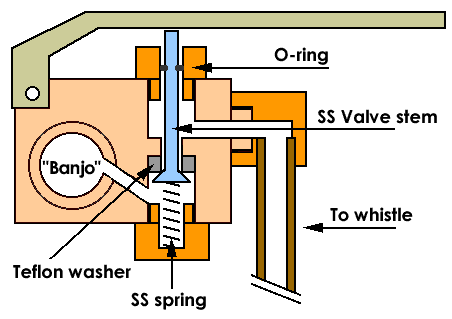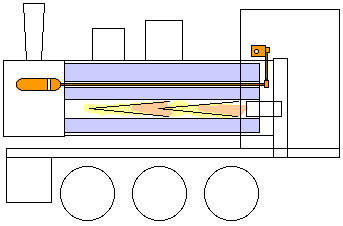I have made some changes and improvements to the 0-6-0 over the past few weeks.
One addition is a hand brake, seen here on the left. The steam brake was impractical, it was simply too slow to be useful, and needed a steam pressure of at least 4 bars (50 psi) to be effective. This hand brake uses the same linkages, I just removed the steam brake cylinder and replaced it with a link to the handle & ratchet.
Here you can also see the burners as installed, with the propane lines coming in under the floor of the cab. I'll still make a wooden floor for the cab, to cover the cut-outs in the steel floor - the large cut-outs are necessary so I can set down the entire cab onto the loco frame, with all running gear already installed. The original loco also had a wooden floor covering, by the way...
One very important change was the upper connection to the water glass, Previously, it was attached to the manifold, from which both the whistle and brakes got their steam. Everytime I used the whistle, the water jumped up in the glass, and the whistle got water in the steam. NOT a good practice! So, that is corrected, now. The whistle was also not very prototypical, so I'll make a pair of dummy whistles that look like the originals, and hide a working whistle in the smokebox.
You can see one of the ignition tubes for a propane burner in the fire door opening. I keep using party sparklers, since have still not found a better way to ignite them!
The stainless steel mesh in the glow-cones had deteriorated completely during a summer of running, so I replaced the cones with new ones, made of pure nickel mesh. We'll see if that fares any better - I think the mesh is a consumable, regardless of what material I use, since the mesh temperature is around 1100 °C/1900 °F...
The Walschaerts gear was none the worse after a whole summer of running, some de-greaser from a spray can, and it looked almost like new. The cast iron wheels, however, have in only 4 months received a patina that no spray can was able to remove...
I did have one rather serious thing to fix: The left-hand main driver had worked loose from the axle, despite the Loctite and a securing key screw. I attribute this to a severe case of condensate in the cylinders - I was once forgetful enough to start the loco without first opening the drain cocks, and I really felt the loco jump when the piston hit the water! In full size, that would have blown out a cylinder cover, I'm sure...
After making these changes (and pressure-testing the boiler again to 16 bars/225 psi, since I had silver-soldered a new bushing for the water glass), I naturally wanted to try out the loco and see if everything was working properly. So, Veijo Kivipelto came over, helped to lift the 120 kg/260 lbs. loco from my workshop onto a 40-ft test track I put up in the back yard, and we steamed it up.
By 5:50 in the evening, the sun had already set, so we had to run in the dark. (Even though we have midnight sun in the summer, days are SHORT in the winter!) I had installed a rechargeable lead-acid gel battery in the coal bunker, so the headlights were working for the first time! The little halogen bulbs' parabolic reflectors made nice light beams in the steam!
I was able to snap a picture of a smiling Veijo as he tried out all the new things, but...
... in the one he shot of me, I'm all steamed in!
Fortunatley, all changes and additions to the loco worked well. It may be that this was the last time the 666 was steamed up this year, the snow is bound to arrive soon.
Hey! Maybe I should build a snow-plow to attach to the front buffer bar!?!
A couple of weeks later...
I've now also added the steps to the cab, the numbers and the type no. and max. speed on the cab side. Note that this loco type was originally an L1 - the typing system changed in the 1940s, as did the max speed, so later on it was known as a Vr1, with a max. speed of 25 km/h. I can almost run at that speed in 1/8th scale...
Today, Nov. 13th, was definitely the last running day this year. The temperature was just a couple of degrees above freezing, and we've had night frosts for a month already. I've now put both the 3003 and the 666 into winter storage in my basement workshop.
I believe I never showed you the simple "ramp" I use to roll the loco out on, to facilitate lifting it in and out of the car. Even though the track piece bends under the load, it is sturdy enough to support the 120 kg (265 lbs) loco. The ramp "foot" is hinged and will fold in, for easy transportation.
One more addition - the whistle! The 3003 has a couple of "peanut" whistles on the steam dome, with uncomfortable high pitched sound, so I'll get a more mellow tone with the 100 mm long, 20 mm dia. (4 x 3/4") whistle which is hidden in the smokebox of the 666. The whistle valve is attached directly to the steam manifold, with a combined banjo union/valve body.


These drawings show the construction. The valve body/banjo block is 12 x 18 x 25 mm (0.5 x 0.7 x 1"), so it was pretty finicky to get all the channels, plugs and unions to fit...
Thanks to the teflon ring washer, the valve is self-sealing. The copper tube goes through a hole in the boiler wrapper, and then via a 90° elbow into the backhead end of one of the boiler tube stays all the way into the smokebox! This will also prevent condensation from forming in the whistle line, since it is surrounded by the boiler heat all the way.